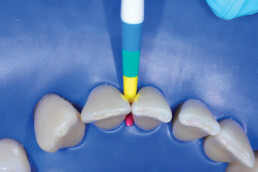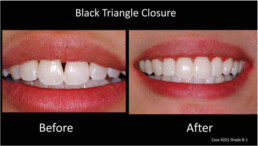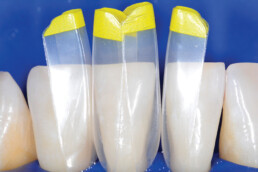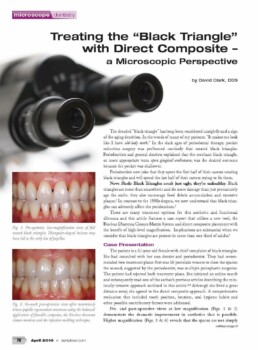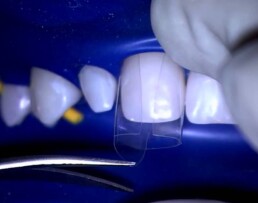The Mother of All Black Triangles
"Sometimes a particular case comes along that appears, at first, to be overwhelming. The case described in this article fits that description. However, when this patient emailed my office and inquired about the possibility of flying across the country to have me treat him, I had fortunately done many cases involving hundreds of teeth using the matrix system that I developed to treat dentition afflicted with black triangles, albeit none of this magnitude. I felt absolutely confident that we could achieve a good outcome. The trick was to disassemble the case into bite-sized pieces. This case presents many excellent questions and the additional challenge of severe facial abrasions. I will first review the background of black triangles and of lower incisor complications, and then proceed with the presentation of the clinical procedures used to treat this particular patient."
Treating the Dreaded Black Triangle
This case presents many excellent questions and the additional challenge of severe facial abrasions. First Cosmetic Dentist Dr David Clark reviews the background of black triangle gaps between teeth and of lower incisor complications and then proceed with the presentation of the clinical procedures used to treat this particular patient.
Michael’s Black Triangle Teeth
https://youtu.be/VVAfdaKHToY
Michael is a Doctor who contacted our dental office in Tacoma, concerned about his smile, because of the black triangle-shaped gaps between his teeth. His situation was not unique. You see, roughly 30% of adults have open gingival embrasures commonly known as black triangles. These dark gaps between teeth can make a smile look older than it is and even lead to dental health problems because they can result in excessive plaque or food particle build up. Fortunately for Michael, the Bioclear Method is a minimally invasive and cost effective composite bonding technique that’s an alternative to the porcelain veneers most cosmetic dentist would turn to in order to treat a case like his. It’s ideally suited to closing black triangle gaps, improving the integrity of his gums and the appearance of his smile.
Of course, you don’t have to take our word for it, you can press play and see for yourself.
Treating the "Black Triangle" with Direct Composite
The dreaded “black triangle” has long been considered unsightly and a sign of the aging dentition. In the words of many of my patients, “It makes me look like I have old-lady teeth.” In the dark ages of periodontal therapy, pocket reduction surgery was performed routinely that created black triangles. Periodontists and general dentists explained that the resultant black triangle, or more appropriate term open gingival embrasure, was the desired outcome because the pocket was shallower.
Periodontists now joke that they spent the first half of their careers creating black triangles and will spend the last half of their careers trying to fix them.
News Flash: Black Triangles aren’t just ugly, they’re unhealthy. Black triangles are more than unaesthetic and do more damage than just prematurely age the smile; they also encourage food debris accumulation and excessive plaque.1 In contrast to the 1980s dogma, we now understand that black triangles can adversely affect the peridontium.2
There are many treatment options for this aesthetic and functional dilemma and this article features a case report that utilizes a new tool, the Bioclear Diastema Closure Matrix System and direct composite placement with the benefit of high-level magnification. Implications are substantial when we consider that black triangles are present in more than one third of adults.3
Case Presentation
The patient is a 41-year-old female with chief complaint of black triangles. She had consulted with her area dentist and periodontist. They had recommended two treatment plans: first was 16 porcelain veneers to close the spaces; the second, suggested by the periodontist, was multiple perioplastic surgeries. The patient had rejected both treatment plans. She initiated an online search and subsequently read one of the author’s previous articles describing the minimally invasive approach outlined in this article.1,4 Although she lived a great distance away, she agreed to the direct composite approach. A comprehensive evaluation that included tooth position, bruxism, oral hygiene habits and other possible contributory factors were addressed.
Pre- and post-operative views at low magnification (Figs. 1 & 2) demonstrate the dramatic improvement in aesthetics that is possible. Higher magnification (Figs. 3 & 4) reveals that the spaces are not simply blocked out with composite, but that the papilla has truly been regenerated without the need of surgery.
After a rubber dam was placed, I applied disclosing solution to aid in thorough de-plaquing of the teeth (Fig. 5). Clinicians should be reminded that phosphoric acid placed to etch the tooth will not remove plaque and is a leading cause of discoloration and microleakage of bonded restorations. Other than aggressive spraying of the teeth with a mild abrasive (such as a Prophy Jet or Bioclear Prophy Plus), no mechanical preparation of the tooth is necessary (Fig. 6). A new matrix design specific for diastema closure (Figs. 8-10, Fig. 10 on next page), (Bioclear Matrix System patents pending) allows a smooth, yet aggressive, cervical curvature facilitating direct composite architectures that are extremely conducive to papilla regeneration. This is due to two inherent features. The first feature is the ability to forgo a traditional wedge, and to use the papilla as a wedging force (Use of a traditional wedge creates a flat cervical shape. Flat cervical shapes lack the static pressure needed to regenerate papillae). The second feature is a completely appropriate anatomic shape with exaggerated palatal, interproximal, and facial surfaces. This permits the clinician to simply remove the matrix after photopolymerization with little to no interproximal finishing.
When the finish is extremely smooth and there is a lack of a gingival ledge, tissue health can be ideal, even with a very round embrasure form. This modern view of cervical curvature is in sharp contrast to the outdated notion that prosthetic and restorative embrasures should be flat.
Total etch remains as the most robust method when bonding to large enamel areas, especially on uncut enamel. There is no need to stabilize the Bioclear matrices as they are designed to be self-stabilizing. Alternatively, a metal matrix can be utilized, however it must first be hand burnished and annealed over an alcohol torch (not pictured).
After placing the bonding agent, an initial small increment of flowable composite is carefully injected in both teeth to fill this crucial cervical area (Figure 11). Advanced magnification is of paramount importance for this step. Advanced magnification has become the standard for optimal softtissue response. A flowable composite, rather than a paste composite, is preferred for this first increment. A paste composite would be nearly impossible to place in this “claustrophobic” area without voids and without disturbing the matrices.
Paste composite is then injected into the reservoir of uncured flowable composite. This process is referred to as the “snow plow technique” and the “injection molding technique.”
The concept of injection molded composite dentistry can be compared to impressioning, in which the low viscosity light body material is syringed into subgingival areas, and then followed and partially displaced by a heavier, highviscosity impression material that has appropriate physical characteristics. In this technique, successively higher viscosity materials are applied in sequence, and the bonding resin and flowable composite act as wetting agents, which are subsequently displaced by the heavier paste composite material. A more comprehensive explanation of the injection molding technique will be presented in a future article in Dentaltown Magazine and further information and clinical videos are available at www.bioclearmatrix.com.
The advantage of anatomically shaped matrices is obvious and a welcomed new tool. Once the matrix is removed, the smooth and extremely durable surface is visible (Fig. 12). The new goal of composite dentistry is to do little or preferably no interproximal finishing. That is because a “Mylar-composite finish” has no oxygen-inhibited layer. We have done microscopic evaluation both intra-orally and on extracted teeth and discovered that an undisturbed “Mylar” finish stays mirror smooth for years, and even decades. Conversely, interproximal areas that the dentist “polished” are often gouged, rough, and stained.
How Much Magnification is “Enough” Magnification?
In my previous article, “A Microscope for Every Dentist” (Editor’s note: see p. 42 of the January 2010 issue of Dentaltown Magazine), I described the levels of magnification available for clinical dentistry. A rule of thumb for magnification that addresses the use of composites is listed in Table 2.
Most dentists using microscopes have found that the levels of magnification they use vary greatly throughout a typical day of general dentistry. Placing an occlusal amalgam on a lower first bicuspid is a far cry from evaluating the subgingival disto-bucccal margin during seating of an all ceramic crown on a maxillary second molar. According to the table, I would need 3 x 2 x 2 x 1.5, or 18 power magnification to see well in that example. And frankly I can barely see that margin at 18X in such a case. And the light can’t be too bright. Similarly in the case of black triangle treatment, there are moments such as placement of the flowable when microscopic visualization is invaluable.
Summary
Until now there were very few dedicated tools or techniques for restoratively driven papilla regeneration. Previous attempts at both diastema closure and papilla regeneration using direct composites often ended with significant compromise in periodontal health. The interdental papilla serves as both an aesthetic and functional asset, and anatomically ideal interproximal composite shapes can serve as a predictable scaffold to regain this valuable gingival architecture. The reader is strongly cautioned that to attempt this elective procedure using no magnification and without appropriate materials may not be in the patient’s best interest, and that non treatment or referral is recommended. This extremely rounded, injection molded composite filling technique is new. Once again, technological advancements allow changes to perform techniques that were previously unthinkable. Slowly, the profession will change its thought patterns, retrain its hands and minds, and allow this substantial clinical evolution in restorative dentistry.
Injection Overmolding for Aesthetics and Strength Part 2
Treatment of black triangles, which was rarely discussed 5 years ago, has exploded since then. Seven years ago, I invented and patented special diastema closure matrices, along with patenting the process of restoratively driven papilla regeneration (US Patent No. 8,393,897). I did a Google search at the time, and there were only a handful of results when I typed in the phrase dental black triangles. Since the release of Bioclear, I have lectured and published extensively about the Bioclear method for treating this difficult problem. The public has definitely begun to catch on, as witnessed by my office having been bombarded with patient requests to fly in for treatment or be referred to someone in their area that has received training. It’s incredible, really. Why the big fuss? Today, that same Google search yields a staggering 348,000 sites mentioning this problem/treatment.
Restorative Papilla Regeneration
When a clinician faces the difficult challenge of papilla regeneration, there are many options available. In this article, I present a feature case that includes restorative treatment followed by papilla regeneration; a discussion of the pertinent literature is included. This case explores a cost-effective, minimally traumatic, and predictable approach. I then briefly review other traditional treatment modalities that are available to resolve this clinical dilemma, including orthodontic treatment or re-treatment, prosthetic intervention, and microsurgical papilla-regeneration procedure.
